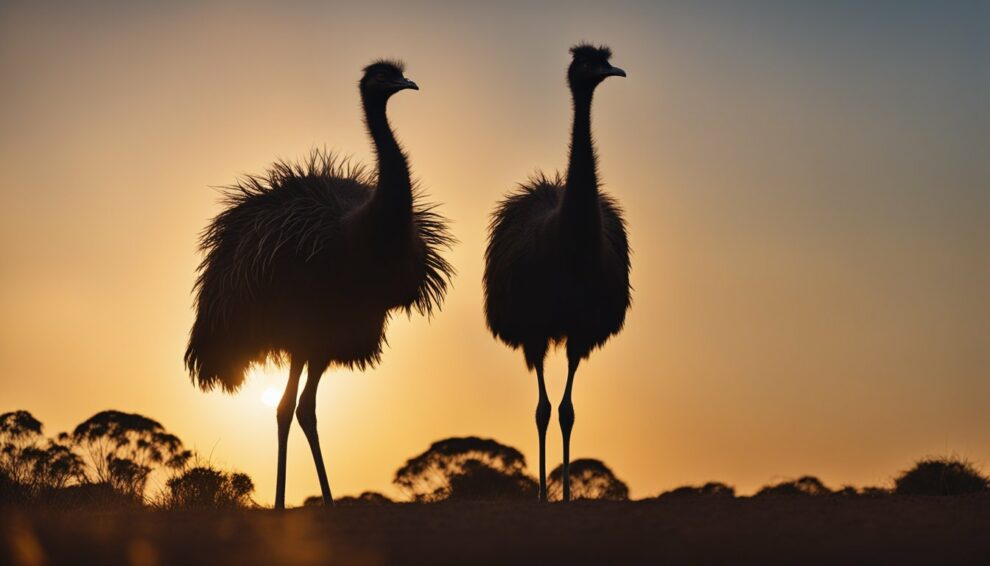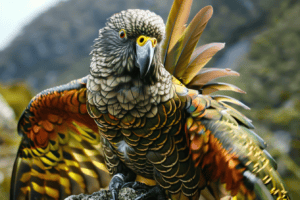In the land down under, a tall and speedy creature roams the vast outback with an unmistakable presence.
The emu, Australia’s national bird, stands as a guardian of the continent’s diverse ecosystem.
These flightless giants, with their long, powerful legs and feathery silhouette, wander the plains and forests, embodying the spirit of Australia with every step.

Interesting to note, emus are not just any bird; they hold a special place in Australia’s history and even its Coat of Arms, sharing this honor with the kangaroo.
Why these two animals? Well, it’s said that neither the emu nor the kangaroo can take a step back, symbolizing a nation that always moves forward.
Imagine a country represented by such a determined and resilient duo!
Have you ever wondered how a bird so large could spend its life grounded?
The emu’s wings may be small, but what it lacks in flight, it makes up for with its agility and the ability to sprint at impressive speeds.
Picture the emu, darting through the underbrush, a blur of brown and grey feathers, perfectly adapted to thrive in Australia’s rugged countryside.
Keep an eye out, and you might just catch a glimpse of this enigmatic bird on your next adventure through Australia’s wilderness.
The Evolution And History Of Emus
Tracing the lineage of the emu reveals a story that bridges extinct giants with modern-day bird species.
This section unfolds the evolutionary journey of emus, from prehistoric ancestors to their place in the family tree of large, flightless birds.
From Genyornis to Emus
Genyornis, an extinct giant bird that roamed Australia, is a key figure in the ancestry of the emu.
Fossil records, including bones and eggshell fragments found across the continent, tell us that Genyornis was part of the Australian megafauna.
Existing during the Pleistocene, these massive birds weighed up to a hefty 240 kilograms (529 pounds).
The species known as Genyornis newtoni met its extinction around 50,000 years ago, which some experts believe coincided with the arrival of early humans.
The progression of time saw the evolution of Genyornis give way to the lighter, more agile emus that grace the Australian landscape today.
Emus have continued to adapt to changing environments over thousands of years.
Their diet is versatile, including a range of plants, seeds, and insects, which has likely aided their survival through diverse epochs and changing climates.
The Emu’s Distant Cousins
Did you know that emus belong to a special group of birds called ratites?
They share this category with the likes of ostriches in Africa, kiwis in New Zealand, and the rhea in South America.
All of these birds are bound by one common trait: they can’t fly. Their wings might be small, but their legs are strong and speedy.
Ratites have a mysterious history; it’s been a puzzle as to how these birds ended up on different continents.
DNA studies suggest that the separation of Gondwana, an ancient supercontinent that included lands now known as South America, Africa, Australia, and Antarctica, played a part in their global diaspora.
While North America doesn’t have its native ratites now, it once hosted its own kinds of giant, flightless birds during the last ice age.
Ever wondered why these birds never took to the skies like their feathered friends? The answer lies in their evolution.
It seems that these birds traded flight for strong legs and big bodies to survive on the ground – a strategy that’s worked out pretty well for the emu.
These adaptations make emus captivating study subjects to comprehend the broader picture of avian evolution and the ecological niches left behind by long-gone megafauna.
Physical Characteristics And Behaviors

The emu, scientifically known as Dromaius novaehollandiae, is a marvel of adaptation with an array of behaviors that have enabled it to thrive in the Australian landscape.
Its striking physical features and intriguing social patterns are a testament to its evolutionary success.
Adaptations for Survival
Possessing a statuesque height of typically 1.75 to 1.9 meters, emus are cloaked in shaggy grey-brown feathers that enable them to blend seamlessly into their surroundings.
One cannot overlook the emu’s strong legs, which are well-equipped for quick, long-distance running at speeds that can reach up to 48 kilometers per hour.
When it comes to survival, the emu doesn’t rely on flight, unlike many other birds.
Instead, they have evolved to become masters of the ground, using their athleticism to escape predators, forage, and explore their often harsh, arid habitats.
Can you imagine traveling vast distances just to dine?
These birds are nomadic by nature, constantly on the move in search of fruits, seeds, insects, and other small animals to satisfy their varied diet.
During the leaner months, they primarily feed on seeds, which are not only plentiful but provide essential nutrients.
It’s an effective strategy that works wonders for these flightless birds, helping them make the most out of sparse resources.
Understanding Emu Social Habits
While emus may appear to be solitary wanderers, they demonstrate quite intriguing behaviors during the breeding season.
They often form pairs, with the female emu laying a clutch of dark green eggs which the male then diligently incubates.
He carries out the role of protecting and nurturing the eggs, ensuring the development of the next generation.
Did you know that these eggs are among the largest of any bird species, and their emerald hue is as breathtaking as it is unique?
The male emu becomes the ultimate stay-at-home dad during this period, rarely eating and solely focused on the hatchlings.
Following their emergence, the chicks are cared for by the male, learning to forage and evade dangers under his watchful gaze.
It’s a beautiful twist in the bird world roles, with the emu breaking the mold of parental expectations.
When not in breeding mode, emus often travel in groups, which can appear quite comical as they trot across the landscape.
Their social structure is loose and can adapt to the changing seasons, which speaks volumes about their intelligence and ability to survive.
So, next time you spot an emu, remember it’s not just a quirky figure on the horizon; it’s a symbol of tenacity, adaptability, and a fascinating social structure that has stood the test of time.
Emus And Humans

The interactions between emus and humans range from causing agricultural headaches to being celebrated as national icons.
Through the dynamics of these relationships, we gain insights into the challenges and areas of harmony within the Australian ecosystem.
Threats To The Emu Population
The Emu, a native bird of Australia, has faced threats from humans since their paths first crossed.
Mostly these threats come from hunting and loss of habitat due to agricultural development.
In the 1930s, emus were seen as pests in the Australian outback, as they invaded farmlands searching for food.
This clash led to the infamous Great Emu War, where despite the efforts of the Australian military, the emus proved to be elusive adversaries.
The birds’ remarkable reproductive success has helped them maintain their population numbers despite these challenges.
Cultural Significance
Emus hold a place of distinction in Australia’s culture.
They appear alongside the kangaroo on Australia’s Coat of Arms, symbolizing the nation’s forward progress, as these animals are primarily known for their inability to move backward easily.
The bird is deeply embedded in Indigenous Australian lore, often linked to creation stories and respected for their survival skills.
Across Australia, including regions like Tasmania, they are recognized as a significant part of the natural history and identity.
Scientific Contributions
Emus are valuable to scientific study for several reasons.
They belong to a group of flightless birds known as ratites, which have been roaming the Earth since before continents like Europe existed as we know them today.
Their long lifespan and survival tactics offer rich data for researchers at institutions such as the Australian National University.
By learning how these once potentially extinct creatures have adapted to changing environments, scientists can predict how current species might cope with future global changes.
The emu’s nesting habits provide a window into understanding the role both male and female birds play in ensuring the survival of their young, offering broader insights on avian reproductive success.
Frequently Asked Questions

Emus, with their towering height and curious lifestyle, have a history that’s peppered with both wonder and conflict.
These flightless giants often raise questions about their past and present situations in Australia, particularly concerning their population and the impacts of human interaction.
How has the emu population changed in Australia since 1932?
The emu population in Australia has experienced fluctuations since 1932, especially events like the Great Emu War had an influence on their numbers.
While specific population data from the 1930s is not readily available, emus have shown resilience and continued to maintain a stable population, adapting well to the diverse Australian habitats over the years.
What was the outcome of the historical conflict known as the Emu War?
The Emu War was an unexpected turn of events when, in 1932, the Australian military was called upon to manage the booming emu population.
It turned out to be an unsuccessful operation, with the emus proving to be elusive and difficult targets.
The mission was abandoned, and the emus continued to roam the Australian outback.
How many emus were estimated to be casualties in the Emu War?
It is estimated that approximately 1,000 emus fell as casualties during the conflict out of the tens of thousands that were causing concern amongst farmers.
These numbers, however, were far from the initial goal set by military forces, reflecting the challenge they faced in attempting to contain the birds.
Were there any human casualties during the Emu War in Australia?
The Emu War, despite its name, did not result in human casualties.
It was more of an effort to manage wildlife that led to an unconventional involvement of the military.
The farmers faced economic damage, but there were no physical injuries to people recorded.
What strategies did Australia use in an attempt to manage the emu population?
Australia utilized military force in a notable attempt to manage the emu population, deploying soldiers with machine guns to cull the birds.
After the failure of this method, exclusion barrier fencing and more sustainable management techniques, like controlling breeding and establishing protected areas, were implemented.
Are emus still considered a problem in Australia today?
While emus can still cause issues for farmers by damaging fences and crops, they are not considered the widespread agricultural problem they once were.
With better management practices and an understanding of their ecological role, Australians have learned to live alongside these incredible birds.
Emus continue to thrive in their natural habitat, embodying the wild spirit of the Australian landscape.









